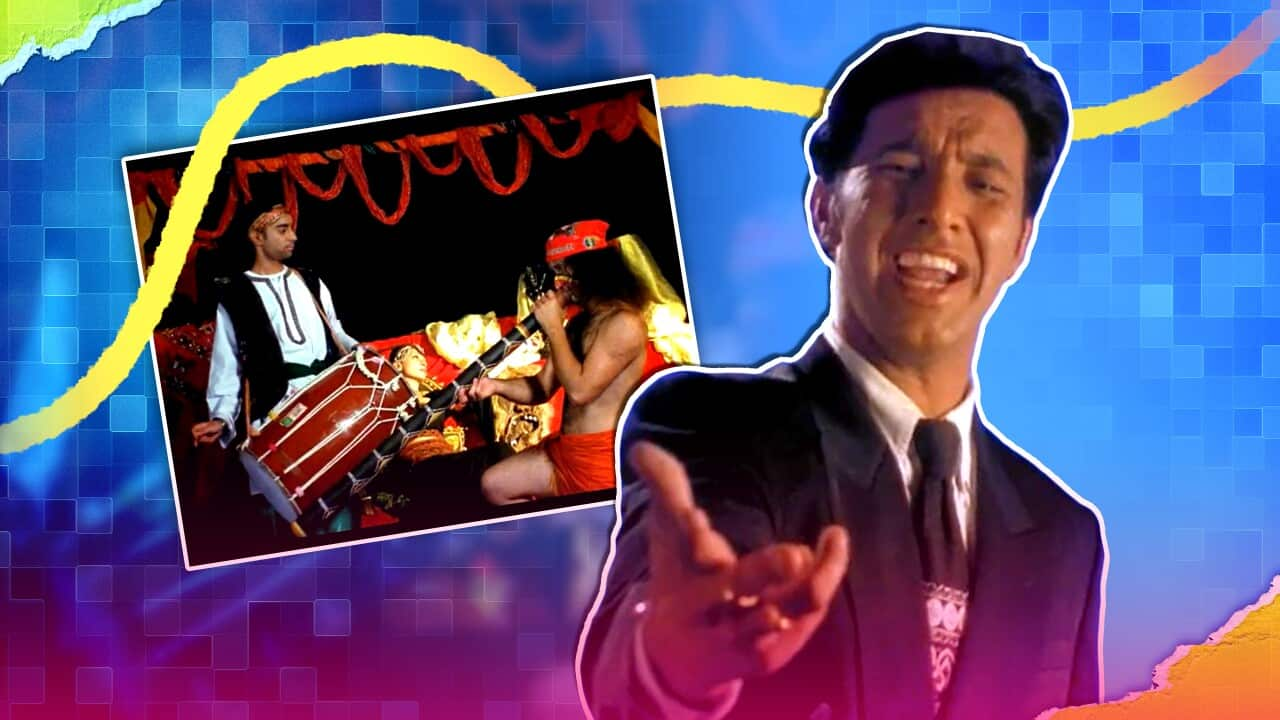Key Points
- Pupinder Mintu’s ‘Didgeridoo Bhangra’ reached number 4 on the MTV Asia Top 10 chart in 1996.
- The music video was directed by filmmaker Anupam Sharma and featured Sydney’s iconic landmarks.
- Blak Douglas, an Indigenous Australian didgeridoo player, says there are similarities between the instrument and Indian percussion.
“It’s one of my favourite and most emotional projects,” Sharma told SBS Punjabi of the music video, which he uploaded to YouTube in 2021.

A still shows musicians playing the dhol and didgeridoo in the music video for ‘Didgeridoo Bhangra’. Credit: Supplied / Pupinder Mintu and Anupam Sharma
The song — performed in the energetic bhangra folk dance style originating from the Punjab region of India and Pakistan — is notable for featuring the didgeridoo alongside Indian percussion instruments like the dhol (a type of double-headed barrel drum).
Back in 1996, the music video reached number 4 on the MTV Asia Top 10 chart.
How did the dhol meet the didgeridoo?
“A lot of people gave me love for it. We had seen many singers from England, but the community was happy to see someone from Australia being recognised,” he said.

Pupinder Mintu in a still from ‘Didgeridoo Bhangra’. Credit: Supplied / Pupinder Mintu and Anupam Sharma
Mintu said that as a child he had a passion for learning music and collaboration, which only grew when his family migrated from Jalandhar, India, to Perth, Australia, in 1984.
Growing up in Perth, our original landowners, the Aboriginal people, loved the didgeridoo, and we used to see them playing the instrument all the time.
Pupinder Mintu
The classically trained yidaki player shared the correlation between the didgeridoo and Indian percussion instruments like the tabla (hand drums).
The language that you learn to play the yidaki is directly connected to how a tabla drum is played – it is a phonetic language that is pronounced with the tongue, and master tabla players speak the same language.
Blak Douglas
“We found one guy, a young fellow, and he played freelance didgeridoo for three hours and we included parts that matched the pitch of the song in the final cut,” Mintu recalled.
Sharma said: “For Mintu to use the inherent beat of the didgeridoo and mix it with the bhangra beats was pure genius.”
“There were not many Punjabi singers in the late ‘90s, and Mintu was the first Punjabi singer from Australia,” he added.
Bridging cultures through music
Sharma said the music video was filmed in four days with the aim of spotlighting Australia’s landmarks and diversity.
Using diverse elements and multiculturalism was in our DNA and (we felt) it shouldn’t be a tick (box) item, it should be natural.
Anupam Sharma
Such cross-cultural collaborations “play a very important role in an inclusive society,” he added.
“I was searching for my identity like many of our youth, and I was desperate to have an affiliation to my Aboriginal ancestry. I wanted to be the guy playing the ‘didge’ (didgeridoo),” he shared.

Still from ‘Didgeridoo Bhangra’. Credit: Pupinder Mintu and Anupam Sharma
Victorian Commissioner for Aboriginal Children and Young People Meena Singh, a Yorta Yorta and Indian woman, said multicultural musical collaborations can positively impact social inclusivity.
